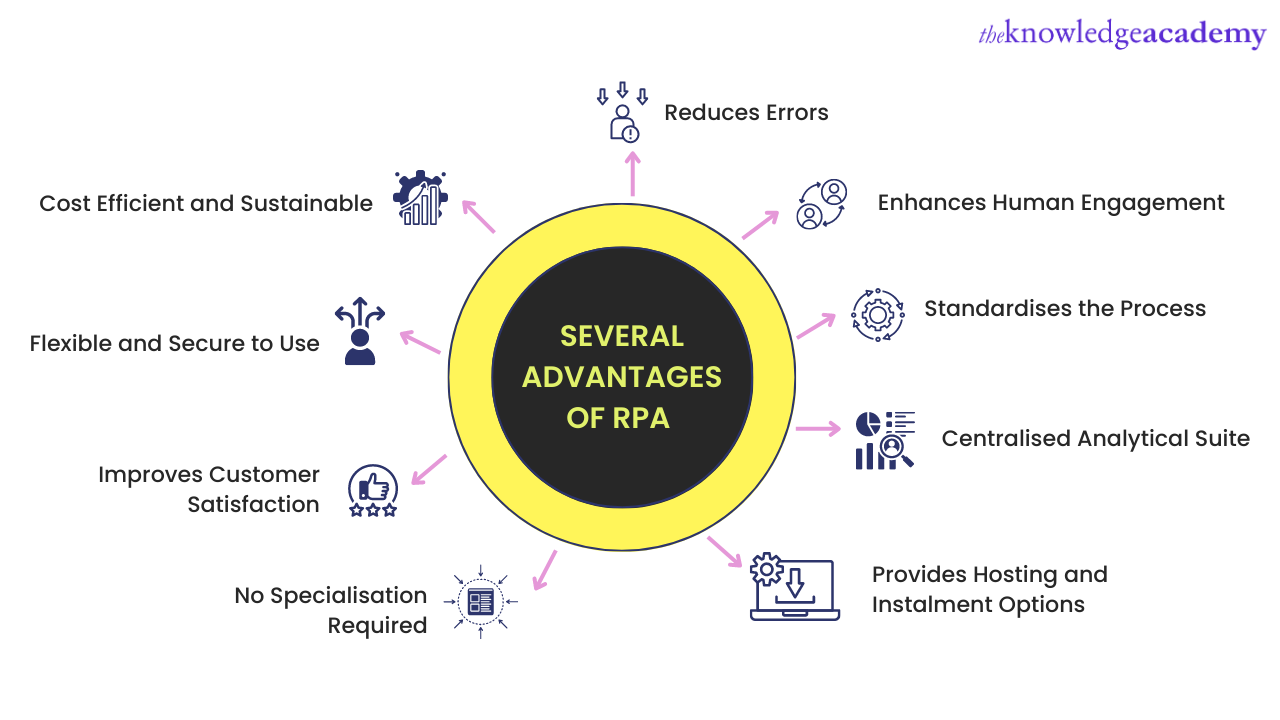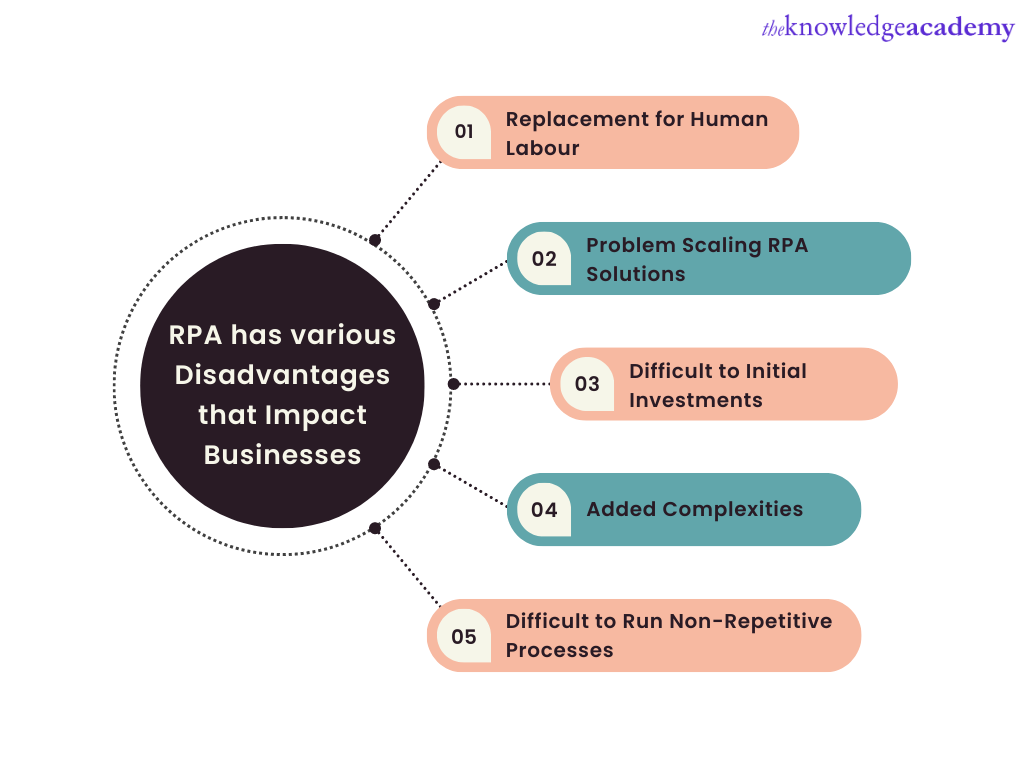We may not have the course you’re looking for. If you enquire or give us a call on +64 98874342 and speak to our training experts, we may still be able to help with your training requirements.
Training Outcomes Within Your Budget!
We ensure quality, budget-alignment, and timely delivery by our expert instructors.

Robotic Automation Process (RPA) is one of the wonders of technology that has knowingly and unknowingly become an integral part of our lives. These are software robots designed to use business logic to perform daily digital tasks that otherwise are performed by human labour. However, not everything is excellent about RPA; along with advantages, there are Disadvantages of RPA too.
Nevertheless, RPA has taken over human labour intensively over the past few years. This is why the RPA Market size is estimated to reach £15.52 billion by 2030, with a compound annual growth rate of 22.5% from 2022 – 2030.
For instance, today, ordering food online has become a work of a blink of an eye; you just need to select your favourite dish, enter the location, place an order and make the payment. But it has some implied drawbacks like your location might be misread.
So, how would a business decide whether it should use RPA? What can be some pros and cons of using RPA? Learn about the Advantages and Disadvantages of RPA through this blog.
Learn how to use different automation techniques and eliminate human errors; register for our Robotic Process Automation Training course now!
Table of Contents
1) Learn about the Advantages of RPA
a) Reduces errors
b) Enhances human labour engagement
c) Standardises the process
d) Centralised Analytical suite
e) Provides hosting and instalment options
f) No specialisation required
g) Improves customer satisfaction
h) Flexible and secure to use
i) Cost-efficient and sustainable
2) All you need to know about RPA Disadvantages
a) Complete replacement for human labour
b) Problem scaling RPA solutions
c) Costly for initial investments
d) Added complexities
e) Difficult to run non-repetitive processes
3) Conclusion
Learn about the Advantages of RPA

Robotic Process Automation (RPA) is a continuously growing technology due to the various Advantages of RPA that are useful for organisations and users. Whether looking for finance process updates, automated accounting, maintaining incoming mail, improving customer services, etc., automation is the answer to all these tasks. So, what are the Advantages of RPA automation? Let's find out:
Reduces errors
Humans may make mistakes very often. However, RPA’s automated tools can work more precisely and quickly than humans. Thus, it boosts organisations’ accuracy and speed to manage simple tasks faster.
Enhances human labour engagement
RPA automates repetitive tasks, eliminating tedious labour and increasing employee satisfaction and engagement. This helps employees focus on other priority projects and work, thus improving the organisation’s productivity.
Standardises the process
While organisations regularly enhance their processes, ensuring that employees follow the desired processes at every time and every office location is difficult. Individual employees may alter the steps according to their convenience. However, RPA functions precisely the way it is programmed to. Thus, ensuring that security, quality, and data integrity standards.
Centralised analytical suite
RPA software has an inbuilt analytical suite to examine the bot’s performance and workflow. This suite provides help in managing and tracking bot operations, such as basic metrics and workflow, and determining issues from a centralised console which can be accessed from anywhere. Also, there is no requirement to integrate the RPA suite with other networks, as management and tracking operations are already available.
Provides hosting and instalment options
Installing RPA across Virtual Machines (VMs), terminal services, and various cloud environments is possible. Organisations can deploy RPA tools on their systems and servers to access data for completing daily tasks. It automatically deploys robots in massive groups that can perform different tasks simultaneously.
No specialisation required
Using RPA automation does not require any expert know-how in programming and coding languages. Modern tools are integrated with RPA at various levels to automate organisational tasks. Hence, the employees only require training in RPA to quickly and effortlessly build robots using Graphical User Interface (GUI).
Improves customer satisfaction
An automated organisation implies a quicker and more efficient delivery of products and services. For example, when you call customer care, you are answered by a pre-recorded bot to solve your queries. A robot makes it easier to access and retrieve information to answer a customer’s request in real-time, cutting short the time to solve the query.
Eager to learn more about Robotic Process Automation, refer to our blog on "RPA testing"
Flexible and secure to use
RPA allows businesses to make quick digital adjustments within the RPA software. Users who want to adopt a long-term strategy can effortlessly do so by apprehending mouse clicks and keystrokes with a built-in screen recorder component. Furthermore, the entire automated data, audits, and instructions the bot access are encrypted to eliminate malicious threats.
Cost-efficient and sustainable
While human labour might sometimes remain absent, RPA helps businesses perform daily tasks regardless of the situation. It also ensures that the process is followed consistently, yielding the desired results across locations. Thus, RPA is sustainable and produces exceptional results at lower costs.
Learn to work with web adapter match rules and define windows adapter design properties; register for our OpenSpan RPA Training course now!

All you need to know about RPA Disadvantages
While RPA is a future-oriented and continuously developing technology that eases human labour, technology has never been able to cover up for human mind entirely. Despite its miraculous supremacy, RPA also comes with certain drawbacks. So, let’s briefly look at what are the Disadvantages of RPA:
Complete replacement for human labour
It is implied that with robots taking over human employees, there is a loss of potential job creation. Since robots can function faster and more precisely than humans, the human labour market is at risk due to the limited job opportunities resulting in a significant life-threatening phenomenon.
problem scaling RPA solutions
Enterprises can run into problems scaling RPA solutions because of internal and regulatory updates. Executives who see RPA as a tactical point-by-point offering rather than a tool that's part of a holistic strategy will get more limited benefits.
Enterprise leaders who want RPA to support their digitisation objectives must have a strategic plan for prioritising their automation projects and understand how those projects fit into their overarching strategic visions.
Difficult to initial investments
RPA is still developing, so it becomes difficult for businesses to decide whether to deploy RPA for their daily tasks or wait until its fully developed version is available. So, you must be a well-developed business if you want to implement this technology, or efforts may be in vain.
Added complexities
If not appropriately documented, RPA develops layers upon layers of software. While organisations add more and more bots to perform their tasks, it creates the risk of a massive collection of bots that, in turn, becomes more problematic and costly to control and flourish.
Difficult to run non-repetitive processes
It is essential to review, reengineer and optimise processes before automating them; otherwise, process automation will be at risk. But what is more problematic is that non-standard or non-repetitive tasks are even more difficult to automate and require human interaction to complete those processes. Thus, even if you think RPA could replace human labour, it is restricted to performing specific tasks.
Conclusion
Robotic Process Automation (RPA) is the future of the technological world. It is growing at a faster pace than ever. RPA can provide a large number of business solutions with the use of business logic to perform regular digital tasks.
But one cannot rely entirely on this technology as there are several Advantages and Disadvantages of RPA. It can work with precision and flexibility, and the centralised suite can do wonders for firms who want to mark their presence in a highly competitive market. However, there are Disadvantages of RPA that restrict businesses from opting for this technology.
Understand the process of installing ROS Electric and ROS Fuerte using Repositories; join our Robot Framework Training course now!
Frequently Asked Questions
Upcoming Business Analysis Resources Batches & Dates
Date
 Robotic Process Automation using UiPath
Robotic Process Automation using UiPath
Thu 16th Jan 2025
Thu 6th Mar 2025
Thu 22nd May 2025
Thu 24th Jul 2025
Thu 4th Sep 2025
Thu 20th Nov 2025
Thu 11th Dec 2025







 Top Rated Course
Top Rated Course




 If you wish to make any changes to your course, please
If you wish to make any changes to your course, please


